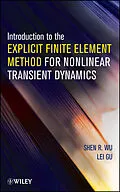A systematic introduction to the theories and formulations of the explicit finite element method As numerical technology continues to grow and evolve with industrial applications, understanding the explicit finite element method has become increasingly important, particularly in the areas of crashworthiness, metal forming, and impact engineering. Introduction to the Explicit Finite Element Method for Nonlinear Transient Dynamics is the first book to address specifically what is now accepted as the most successful numerical tool for nonlinear transient dynamics. The book aids readers in mastering the explicit finite element method and programming code without requiring extensive background knowledge of the general finite element. The authors present topics relating to the variational principle, numerical procedure, mechanical formulation, and fundamental achievements of the convergence theory. In addition, key topics and techniques are provided in four clearly organized sections: Fundamentals explores a framework of the explicit finite element method for nonlinear transient dynamics and highlights achievements related to the convergence theory Element Technology discusses four-node, three-node, eight-node, and two-node element theories Material Models outlines models of plasticity and other nonlinear materials as well as the mechanics model of ductile damage Contact and Constraint Conditions covers subjects related to three-dimensional surface contact, with examples solved analytically, as well as discussions on kinematic constraint conditions Throughout the book, vivid figures illustrate the ideas and key features of the explicit finite element method. Examples clearly present results, featuring both theoretical assessments and industrial applications. Introduction to the Explicit Finite Element Method for Nonlinear Transient Dynamics is an ideal book for both engineers who require more theoretical discussions and for theoreticians searching for interesting and challenging research topics. The book also serves as an excellent resource for courses on applied mathematics, applied mechanics, and numerical methods at the graduate level.
Autorentext
SHEN R. WU, PHD, has teaching and research interest in shell theory, the finite element method, the variational principle, and contact problems. In addition, he has extensive experience in the explicit finite element method, including the convergence theory, the diagonal mass matrix, the Reisner-Mindlin element, contact algorithms, material models, software development, and its applications.
LEI GU, PHD, has teaching and research interest in fracture mechanics, the finite element method, the mesh-free method, the optimization method, with extensive experience in the explicit finite element method such as software development, the diagonal mass matrix, robustness analysis, and its practical applications.
Inhalt
Preface xv
Part I Fundamentals 1
1 Introduction 3
1.1 Era of Simulation and Computer Aided Engineering 3
1.1.1 A World of Simulation 3
1.1.2 Evolution of Explicit Finite Element Method 4
1.1.3 Computer Aided Engineering (CAE)Opportunities and Challenges 5
1.2 Preliminaries 6
1.2.1 Notations 6
1.2.2 Constitutive Relations of Elasticity 8
2 Framework of Explicit Finite Element Method for Nonlinear Transient Dynamics 11
2.1 Transient Structural Dynamics 11
2.2 Variational Principles for Transient Dynamics 13
2.2.1 Hamilton's Principle 13
2.2.2 Galerkin Method 15
2.3 Finite Element Equations and the Explicit Procedures 15
2.3.1 Discretization in Space by Finite Element 16
2.3.2 System of Semidiscretization 19
2.3.3 Discretization in Time by Finite Difference 19
2.3.4 Procedure of the Explicit Finite Element Method 20
2.4 Main Features of the Explicit Finite Element Method 21
2.4.1 Stability Condition and Time Step Size 22
2.4.2 Diagonal Mass Matrix 23
2.4.3 Corotational Stress 24
2.5 Assessment of Explicit Finite Element Method 24
2.5.1 About the Solution of the Elastodynamics 24
2.5.2 A Priori Error Estimate of Explicit Finite Element Method for Elastodynamics 25
2.5.3 About the Diagonal Mass Matrix 30
Part II Element Technology 37
3 Four-Node Shell Element (ReissnerMindlin Plate Theory) 39
3.1 Fundamentals of Plates and Shells 40
3.1.1 Characteristics of Thin-walled Structures 40
3.1.2 Resultant Equations 42
3.1.3 Applications to Linear Elasticity 44
3.1.4 KirchhoffLove Theory 46
3.1.5 ReissnerMindlin Plate Theory 47
3.2 Linear Theory of R-M Plate 47
3.2.1 Helmholtz Decomposition for R-M Plate 48
3.2.2 Load Scaling for Static Problem of R-M Plate 48
3.2.3 Load Scaling and Mass Scaling for Dynamic Problem of R-M Plate 49
3.2.4 Relation between R-M Theory and K-L Theory 50
3.3 Interpolation for Four-node R-M Plate Element 52
3.3.1 Variational Equations for R-M Plate 52
3.3.2 Bilinear Interpolations 52
3.3.3 Shear Locking Issues of R-M Plate Element 55
3.4 Reduced Integration and Selective Reduced Integration 56
3.4.1 Reduced Integration 56
3.4.2 Selective Reduced Integration 57
3.4.3 Nonlinear Application of Selective Reduced IntegrationHughesLiu Element 58
3.5 Perturbation Hourglass ControlBelytschkoTsay Element 60
3.5.1 Concept of Hourglass Control 61
3.5.2 Four-node BelytschkoTsay Shell ElementPerturbation Hourglass Control 63
3.5.3 Improvement of BelytschkoTsay Shell Element 68
3.5.4 About Convergence of Element using Reduced Integration 70
3.6 Physical Hourglass ControlBelytschkoLeviathan (QPH) Element 71
3.6.1 Constant and Nonconstant Contributions 71
3.6.2 Projection of Shear Strain 72
3.6.3 Physical Hourglass Control by One-point Integration 73
3.6.4 Drill Projection 74
3.6.5 Improvement of B-L (QPH) Element 76
3.7 Shear Projection MethodBatheDvorkin Element 76
3.7.1 Projection of Transverse Shear Strain 76
3.7.2 Convergence of B-D Element 78
3.8 Assessment of Four-node R-M Plate Element 80
3.8.1 Evaluations with Warped Mesh and Reduced Thickness 80
3.8.2 About the Locking-free Low Order Four-node R-M Plate Element 85
4 Three-Node Shell Element (ReissnerMindlin Plate Theory) 88
4.1 Fundamentals of a Three-node C0 Element 89
4.1.1 Transformation and Jacobian 89
4.1.2 Numerical Quadrature for In-plane Integration 91
4.1.3 Shear Locking with C0 Triangular Element 91
4.2 Decomposition Method for C0 Triangular Element with...
